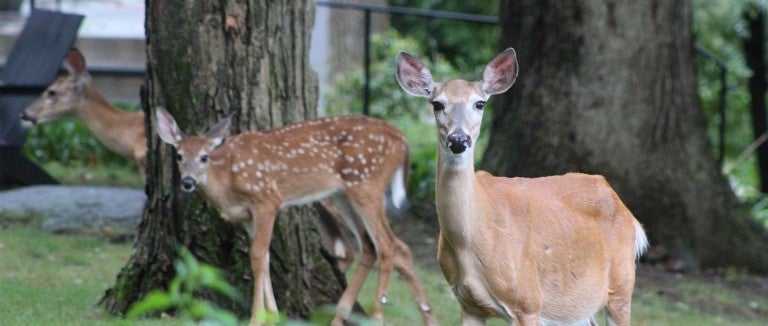For seven years, Kali Pereira of the Humane Society of the United States crept up on deer in the steep, tight, wooded neighborhoods of Hastings-on-Hudson, north of New York City. In and around the small yards of the densely populated village. Watching for dogs—some leashed, others running loose in the woods—and children and commuters. She peered around trees and shrubs and fences, tracking which property owners would allow her on their land (green flag on mailbox) and which would not (red flag).
Pereira and her research team had one goal: Darting at least 60% of the village’s breeding females to understand whether a contraceptive could be safely delivered to enough suburban deer to reduce their numbers and their impacts in a busy community setting where deer moved freely.
Other HSUS-supported studies had shown the contraceptive PZP (porcine zona pellucida) reduced isolated populations of deer, such as those on Fripp Island, South Carolina, cut off from the mainland. But would it work in Hastings-on-Hudson, where deer could come and go? If deer numbers fell, wouldn’t outside deer move in and push the population back up, as happens when deer are culled?
Pereira joined the team of HSUS staff members and Tufts University students working on the Hastings-on-Hudson project in 2015, a year after it started, as a graduate student, under researcher Allen Rutberg, director of the Center for Animals and Public Policy at the Tufts Cummings School of Veterinary Medicine. Now HSUS senior wildlife field manager, Pereira and team members visited the village each winter, summer and fall. At first, they sedated and tagged does to identify them, then hand-injected a version of PZP that prevents births for two years. Later, they delivered second doses by dart. They checked whether the does had fawns the next year and monitored the population.
As time went by, Pereira grew more confident. The team had treated more than 60% of does and relocated and revaccinated half of them. She typically only saw fawns in areas where the team could not treat deer. Deer numbers were dropping. New deer were not rapidly moving in—there was no room for them. Most of the treated does stayed, tucked into the suburban neighborhoods where they had long found food. The deer population fell by 50% over five years. During the same period, the police department recorded a 50% reduction in deer-vehicle collisions.

A second milestone from the research: The study showed there is no need to dart deer every year, says Rutberg. “We can do two shots over two and a half years and probably get five years [of contraception].” That makes administering the contraceptive much more practical.
In May, Rutberg and Pereira presented their findings at the 9th International Conference on Wildlife Fertility Control in Colorado Springs. “It was a big challenge,” Pereira says, “but we’re saying, ‘Yeah, it can be successful.’ ”
The study is an important step toward understanding how contraception might fit into comprehensive humane deer management plans for communities. Next up: Pereira and Rutberg are researching techniques to reduce the need to handle animals prior to administering PZP, which will make it cheaper and easier to use.
Pereira cautions that contraception shouldn’t be the primary way most communities deal with complaints about deer. Rather, they must understand the nature of the conflicts and try already available means: fencing gardens; preventing accidents with warning signs. The issue might not be too many deer, but learning to live with them.
Want more content like this?
This was written and produced by the team behind All Animals, our award-winning magazine. Each issue is packed with inspiring stories about how we are changing the world for animals together.
Learn MoreSubscribe
